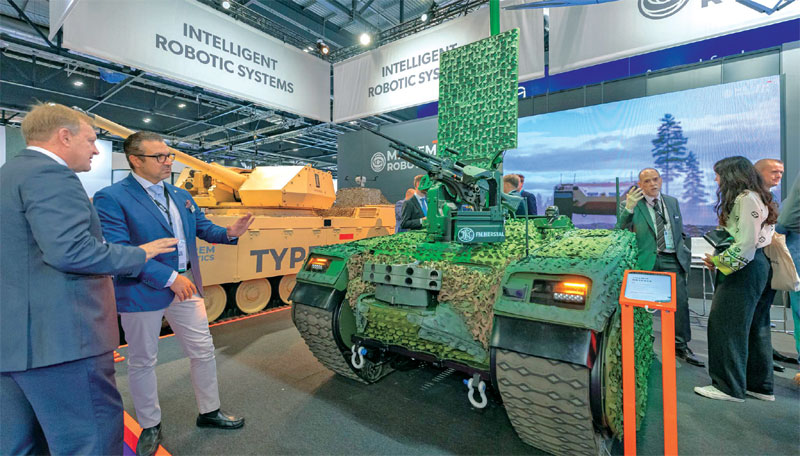Greater use of UGV could allow the Indian Army to redeploy personnel for more pressing tasks
Atul Chandra
The Indian Army is modernising at a far slower pace than desirable and is also grappling with what appears to be an insurmountable challenge in reducing its manpower. With an estimated 12,37,000 active troops, the Indian Army is one of the world’s largest standing armies and also has 8,00,000 reserve troops. It is also the largest standing volunteer army in the world. While there could be some comfort in these numbers, the fact of the matter is that most militaries the world over are downsizing to fund their modernisation priorities.
Unmanned ground vehicles (UGV) are an emerging defence technology which can meet the twin priorities of modernising the armed forces while also allowing for a reduced manpower count. It will allow a greater proportion of troops to be utilised in combat-facing roles and enhance the army’s ‘teeth to tail’ ratio.

The Indian Army presently needs greater numbers of UGVs which can undertake unmanned autonomous capturing of intelligence, surveillance and delivery of loads/casualty evacuation, etc. The army’s armoured and mechanised infantry units currently employ vehicle-based Doppler radars and handheld thermal imaging (TI) sights manned by three to four personnel, for surveillance of the enemy.
Even for tasks such as casualty evacuation and immediate replenishment of ammunition/ fuel to individual armoured fighting vehicles (AFV) the army presently uses wheeled unprotected vehicles manned by a crew of four. These manned vehicles also have a large size and silhouette and thus are easily detected by the adversary or are deployed at standoff distances. Replacing these vehicles in their entirety with UGVs by 2035, should be undertaken on a war footing.
Unmanned Future
The Indian Army has announced plans for the induction of unmanned autonomous systems, but this has led to a proliferation of unmanned aerial vehicles (UAV) whereas the development of UGV technology has been slow. This can chiefly be attributed to a lack of user awareness on the performance and capability of current-gen military UGVs.
However, the Indian Army is now actively exploring integrating UGVs into its operations for various purposes, including reconnaissance, surveillance and logistics support but is yet to put out specific details about the types and numbers of UGVs it requires for various purposes.
The Army does operate an unknown number of Milrem Robotics THeMIS UGVs. The multi-mission capable system was designed to support dismounted troops and can transport a squad’s gear. The THeMIS multi-role unmanned system is part of robotics programmes in various configurations in 16 countries around the world, including eight NATO members. The company also offers the THeMIS Cargo, which it says “is intended to support dismounted troops by carrying everything a soldier would normally carry, thus letting the fighter concentrate on the mission at hand.”
Defence minister Rajnath Singh unveiled the enhanced collaborative autonomous rover system (ECARS) developed by the Kalyani Group at the North Tech Symposium at Indian Institute of Technology, Jammu in September 2023. The ECARS is a multi-terrain vehicle available in 4X4 and 6X6 configurations and has a variety of sensors for positioning, mapping, path planning and obstacle detection. It can operate on different types of terrain and can perform surveillance, security, safety and rescue missions and operate in temperatures ranging from minus 20 degrees Celsius to plus 50 degrees Celsius.
At DefExpo 2022, Larsen & Toubro (L&T) showcased for the first time, an autonomous UGV that it developed in partnership with the Defence Research & Development Organisation (DRDO). At that time, the UGVs were undergoing trials with L&T and DRDO. The 6X6 UGVs weigh 800 kilograms and have an endurance of four hours. They can carry a 300-kilogram payload and attain a maximum speed of 20 kilometres per hour. The UGV has a ground clearance of 210 millimetres and features a modular design, which allows it to be fitted with different payloads such as remote-controlled weapon systems, anti-tank mine detection and logistics payloads.
The Army is now eyeing the acquisition of greater numbers of tracked/wheeled UGVs for its Mechanised Forces. It is eyeing the procurement of autonomous combat vehicles (ACV) which can undertake silent, real-time day and night surveillance to provide troops with enhanced situational awareness, as well as undertake casualty evacuation, carriage and delivery of operational loads in deserts, plains and high altitude /mountain terrain. The Army has a stated requirement for 351 ACVs with three of these allocated per Armoured and Mechanised Infantry unit. A similar number of ACVs for Logistic Support are also planned to be acquired.
Global Developments
The Indian defence sector is eyeing the Army’s UGV needs with growing interest. However, the service itself will need to procure a mix of advanced UGVs from abroad, while at the same inducting indigenously developed systems which meet its procurement requirements.
For example, Milrem Robotics’ proven THeMIS UGVs can act as a force multiplier providing direct fire support for manoeuvre units. It is now available with Leonardo’s HITROLE light remote weapon station (RWS) which can be fitted with a 7.62 millimetre/ 12.7 millimetre machine gun or a 40 millimetre Automatic grenade launcher. The RWS is assisted by artificial intelligence (AI) functions for target acquisition, recognition prioritization and tracking, they provide the capability to perform multi-role tasks like surveillance, patrolling, border security, counter-sniper and asymmetric missions. Target engagement is always done by a human operator.
You must be logged in to view this content.

